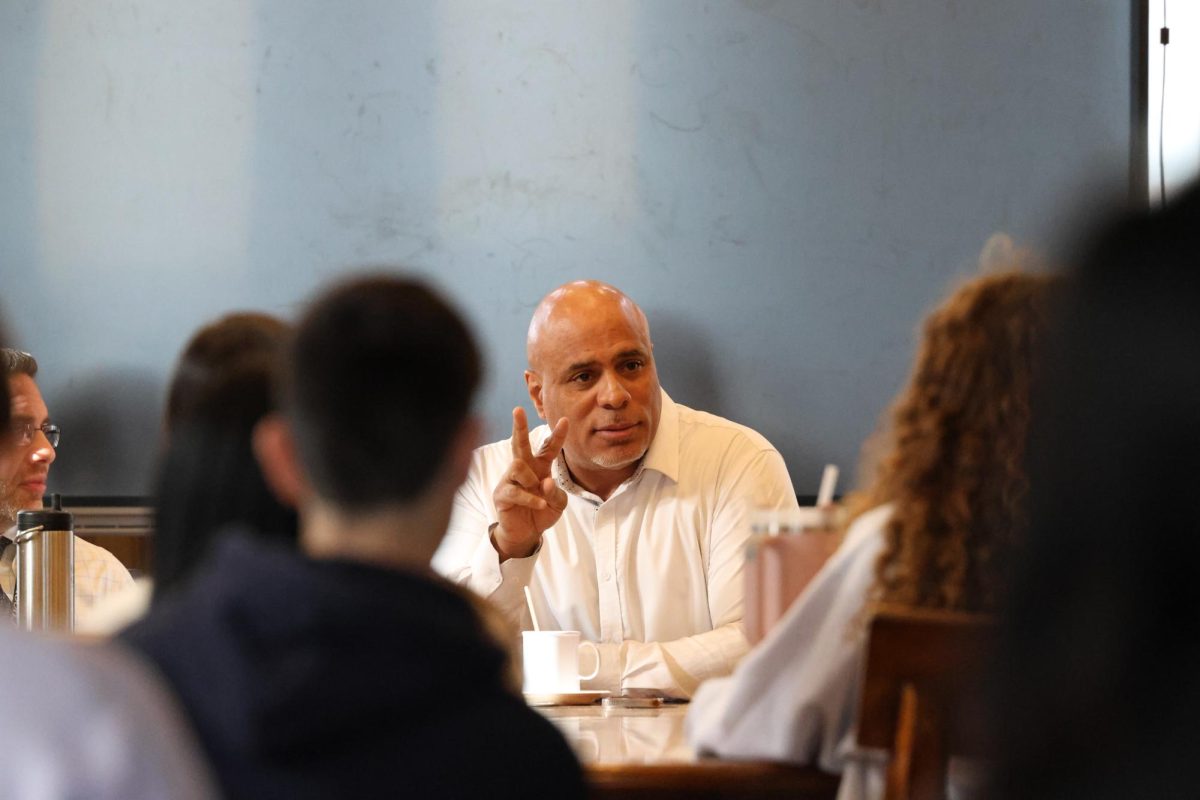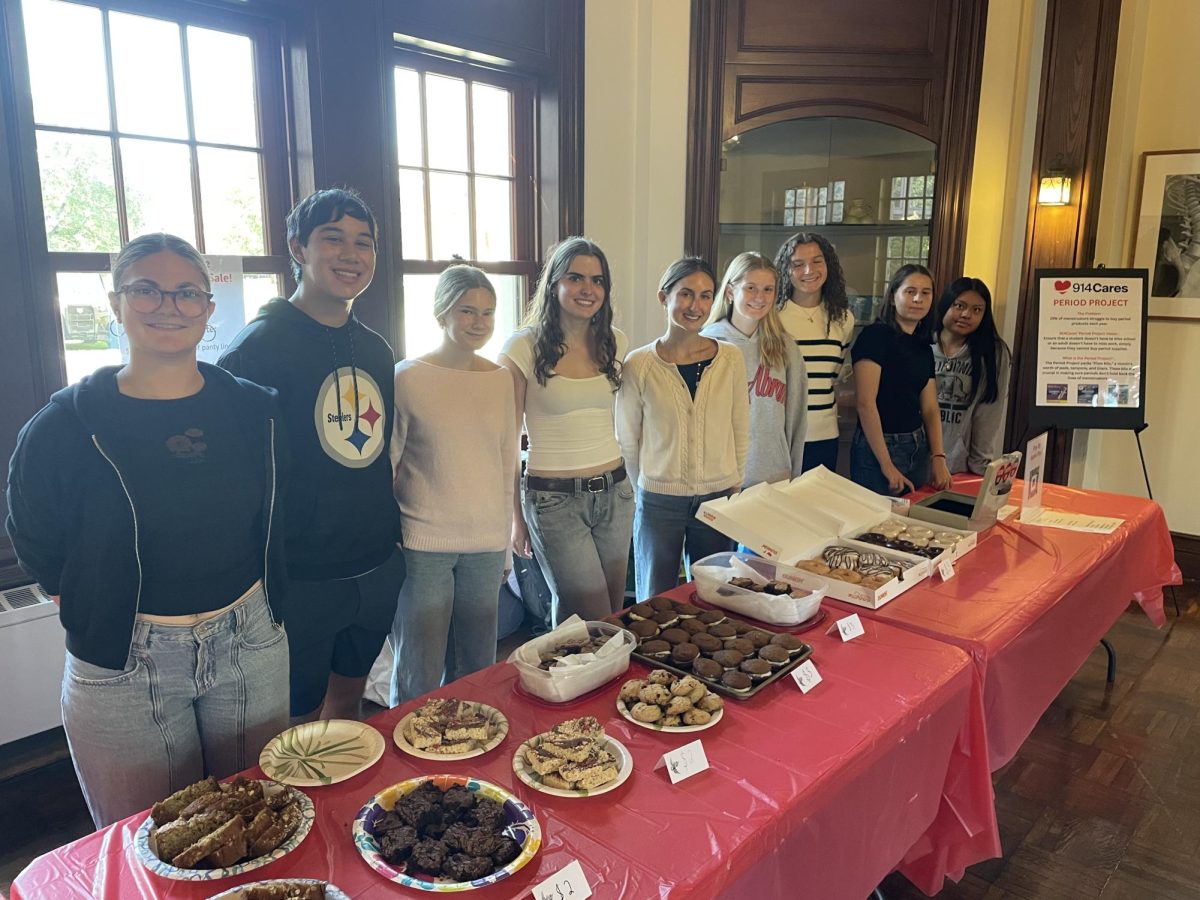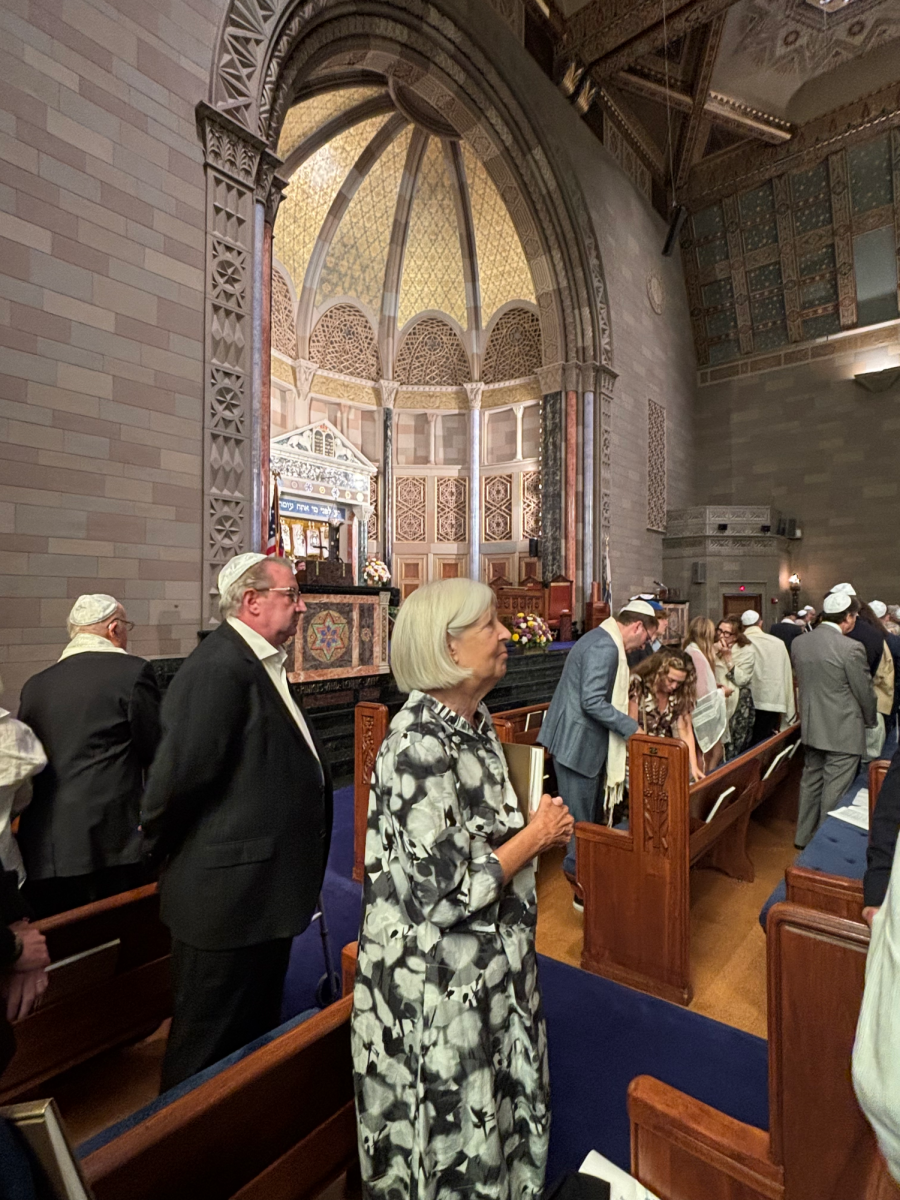Imagine being wrongfully convicted of killing one of your closest friends and then spending the next 27 and a half years in prison paying for a crime you didn’t commit. Your friends, family, and everyone who knew about the case believed you were a murderer. When you finally prove your innocence, you have missed over a quarter of your life and the world has completely changed.
For Shabaka Shakur, this nightmare was his reality and his life story. On December 5th, History Teacher Michael Bass’s American Law class collaborated with the Innocence Project to bring in Shakur to speak about his story for Upper School students during a History Roundtable at lunchtime.
On January 12, 1988, 23-year-old Shabaka Shakur was brought in for questioning about the murder of his close friends, Steven Hewitt and Fitgezerald Clark.
“The most traumatic part was that the people who were killed were friends of mine,” Mr. Shakur told the audience of about 100 students, faculty, and administrators, “We went to school and grew up together and they were murdered. It was traumatic to me to be arrested for the cases and for our families because it made them look at my family differently.”
One of the brothers of the deceased initially told police that he saw Shakur and his brother arguing earlier that day. This caused Shabaka Shakur to become the main suspect in the case. When Shabaka was questioned at the precinct, he made sure to tell the authorities that he was in a different borough of the city and had multiple witnesses who vouched for him at the time of the murders. The original detectives on the case even called these witnesses and verified his alibi. Through this difficult time, Shakur wasn’t worried because he believed in the justice system and that he would be proven innocent sooner or later.
Shakur’s fate took a turn for the worse when now-infamous detective Louis Scarcella was brought in. Detective Scarcella gained notoriety for closing cases that the previous detectives could not. Recently, Scarcella has been s
uspected of fabricating evidence, making up fake
confessions, and lying about not knowing infor
mation that would prove the defendant’s innocence for over a dozen cases.
“Louis Scarcella was known as the closer,” Shakur explained, “He’s the guy that would come in [to] close the cases, nobody else could. He came in and spoke with me for two minutes and accused me of all types of lying and then he left. The next thing I knew he had a whole statement of confession that he [Scarcella] said I told him.”
After the brother of the deceased incriminated Shakur along with Scarcella making a false confession, Shabaka Shakur was indicted for murder. However, Shakur learned later that leading up to the trial, the statement began to change from the deceased’s brother.
“He initially said he didn’t see the shooting but that I had an argument with his brother. Later, he said that he actually ran outside and saw me running away from the scene of the crime. When he came to testify at trial, he said he was standing outside and saw me chase his brother and shoot him twice in the back,” said Shakur.
After he was convicted of murder, Shakur was sentenced to two consecutive 20-year to life sentences at only 21 years of age. A distraught Shakur was sent upstate to await his sentencing where Derrick Hamilton, a fellow incarcerated man, gave him the best advice Shakur believes he had ever received.
“Nobody’s going to get you out, except for you. You can’t rely on an attorney because, at the end of the day, they go home. You are the only one that suffers. You have to work on your case.”
Shakur took this sentiment to heart and began reading anything he could about different murder cases that were overturned due to wrongful convictions. At this time, Shakur was able to get his degree while incarcerated from the college programs that were running in jails across the country.
“Cornell was the college that brought their students and their teachers into the jails. We would go over law cases with students on one side of the classroom and inmates on the other.”
After taking these law classes, Shakur was able to learn enough to get a new trial. Through this process, he realized that to get his freedom, Shakur would have to make some noise about his case. Shakur, Hamilton, and a couple of others began to tell their families and friends outside of the jail to begin organizing protests to garner attention.
While this was happening, Shakur was busy researching more about his case.
“I found out that there was so much evidence that had never been presented. There were witnesses that the police had interviewed that they never let us know about. Witnesses, who disagreed with the police’s account of what happened.”
The brother of one of the deceased testified at trial that he saw Shakur shoot his brother twice in the back. However, his brother died of a single gunshot wound to the chest.
“That’s what the medical examiner said and what the autopsy said. So, this completely contradicted his [the deceased’s brother’s] story. That wasn’t a surprise because his story changed over time from initially not seeing it to something completely different that the physical evidence contradicted.”
Even with this evidence, Shakur found difficulty proving that he did not confess to Louis Scarcella during his interrogation. At this time, Shakur began to work in the prison law library as a law clerk where he would assist other inmates with their cases. With every murder case that Shabaka worked on that was trying to be overturned for a false conviction, he ran into problems with the evidence. Similarly, the cases had the same primary detective responsible for the arrest: Louis Scarcella.
“A pattern started to form. We began to tell everyone with Louis Scarcella in their case to start attacking this together. It was obvious that he was a crooked cop but if one of us said something it wouldn’t mean anything, but if we all said something it might hold some weight.”
When Shakur filed a motion for a new hearing, he centered his argument on questioning Scarcella’s credibility and honesty. While Shakur was waiting to hear back from the court on his appeal for a new trial, a case was reversed due to a false confession with Louis Scarcella as the detective. The overturned case made headlines and the news picked it up. Shakur and the other inmates who were convicted by Scarcella reached out to Frances Robles, the journalist from the New York Times who broke the story, to share their own encounters with Scarcella.
Shakur recalls talking to Robles for the first time about his case and her shocked reaction.
“I sent her the evidence I had and she said this was impossible and that she didn’t believe it. I told her that she didn’t have to believe me but since she was an investigative reporter she should investigate the case.”
A week after the conversation, Robles returned saying that her editor believed Shakur and that she wanted to run a story on his case. This opened the door to an investigation on Scarcella that has freed around 20 men under the cause of wrongful convictions with 50 more cases still pending. Almost everyone in Shakur’s friend group including Hamilton and the rest of the wrongfully convicted inmates got their cases reversed after decades in prison.
Shakur was released after exactly 27 years and six months. It took 13 appeals to get his conviction overturned and it wasn’t until it became newsworthy that the courts accepted his appeal and reversed his conviction. Scarcella’s wrongdoing put him in jail, but the notoriety of his questioned reputation as a detective that he later had allowed Shakur to finally be free.
Shakur took time at the end of his talk to reflect on his process from the very beginning of his sentencing. He reflected on how the brother of the deceased jumped to conclusions and implicated him.
The next person Shakur reflected on was Louis Scarcella. He believes that Detective Scarcella was more concerned with protecting his career and his reputation as “The Closer” – a detective who could close cases that dumbfounded everyone else. Shakur thinks that this aspect of his work should’ve raised red flags surrounding his legitimacy.
Shakur was arrested in the late 1980s when New York City was at the height of a violent crime surge that started in the 1970s and was made even worse by the Crack Cocaine epidemic. Shabaka Shakur believes that a majority of wrongful convictions were due to the stress police officers were under during this crime wave.
“The integrity of the criminal justice system was shaky. They [New York Law Enforcement] were more concerned with closing cases and getting people, that they perceived as criminals, off the streets. And in doing so, there were so many people that were wrongfully convicted. This steamroller mentality ended up with now, every other month somebody gets released for a wrongful conviction. Just last week, someone was finally released for a wrongful conviction from this time period.”
After Shakur was finished telling his story he asked if there were any questions about his story. Students and faculty alike were eager to hear what happened to Louis Scarcella after all of his wrongdoings. Unfortunately, according to Shakur, even while many of his cases are still pending to be overturned, Detective Scarcella is peacefully retired and collecting his pension.
When asked about his transition back into society, Shakur explained why it was so difficult.
“After coming out of jail, it was like living in another world. I went to jail in 1988, there were no cell phones or computers. The technology that exists now was nowhere to be found back then. Coming out, I didn’t know how to use a cell phone. You all think a lot faster because of the internet, you don’t have to research as extensively anymore. Learning how to be in a modern world was a big transition.”
Sophomore Ben Iaderosa asked whether or not the criminal justice system has improved since Shakur’s false conviction.
“I think that technology has made a huge difference. There’s nowhere in New York City where you can go without cameras. Your phone and car are also tracking devices. Anything that happens in the city will be recorded. Technology can prove your innocence by showing where you were during a crime. That helps prove a lot of people innocent now.”
Some students asked whether the person who actually did commit the double homicide was found. Detectives have struggled to find out who did the murders but there is speculation that a man, who is serving a sentence of natural life and an additional 300 years in federal prison, is the real murderer. The man refused to confess or comment on the case while Shakur was sitting in jail for it. Detectives argue that there isn’t much incentive to investigate the case further because the man is already serving a long sentence.
Shakur closed the lunch meeting with a moving statement on the impact of his incarceration.
“My whole youth was spent in prison. My mother passed away while I was in jail and she never got to see me free. She passed away thinking I was a murderer. My father had Alzheimer’s disease and died within a year of me coming home, not knowing who I was. My parents never got to acknowledge the fact that I came home. I have a son now who is four years old. How long do I have to raise him? Money doesn’t make up for the time I did.”
After a thunderous round of applause, students and faculty went on with their day and left Mr. Bass’ American Law class to discuss with Shakur a bit more. The topics ranged from how the law was used against Shakur and how different criminal justice practices have changed to talking about Shakur’s attempt to make a career in the restaurant business after his release from prison. The class was able to learn a lot about Shakur’s life after being exonerated and how his exchanges with law enforcement changed his life.
Shakur’s story really struck senior American Law student Claire Esposito and how it contrasted with her learning in the classroom.
“It was super interesting to hear Mr. Shakur speak about his experience with New York’s justice system. It made me so upset to hear that the cop who created false evidence against all these men, sending them to jail for decades, has faced no punishment. Also, we learn so much about law in class and how the system in the US is supposed to work, so hearing from someone who has dealt with it head-on gave me more perspective on what we have learned so far in American Law.”





















